Food 3D Printing Market Summary
The global Food 3D Printing Market size was at $226.2 million in 2021, and is projected to reach $15.1 billion by 2031, growing at a CAGR of 52.8% from 2022 to 2031. 3D food printing offers the possibility to personalize food to consumers’ individual needs. The growth of the custom food market is the main reason behind the growth of the food 3d printing market.
Key Market Trends and Insights
Region wise, Europe generated the highest revenue in 2021.
The global food 3d printing market was dominated by the commercial segment in 2021 and is expected to maintain its dominance in the upcoming years
The carbohydrates segment is expected to witness the highest growth during the forecast
Market Size & Forecast
- 2021 Market Size: USD 226.2 Million
- 2031 Projected Market Size: USD 15.1 Billion
- Compound Annual Growth Rate (CAGR) (2022-2031): 52.8%
- Europe: Generated the highest revenue in 2021
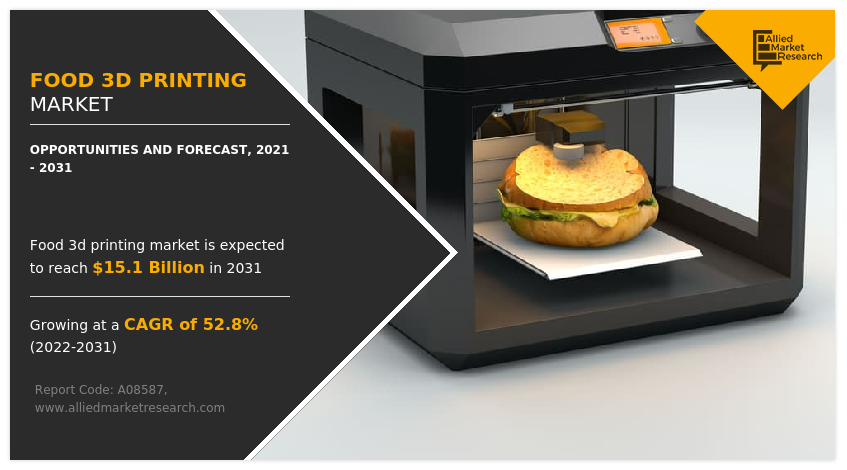
Market Dynamics
A food manufacturing and modification technique called food 3D printing allow for the creation of three-dimensional food products. An assembly of actuators, software, sensors, and storage containers typically made of stainless steel or food-grade plastic are coordinated to function together as a 3D food printer. Incorporating three-dimensional digital designs into delectable real-world foods, 3D food printing not only gives food ingredients three-dimensional shapes however preserves the product's style, framework, and texture. Insect, protozoan, or beet leaf proteins are converted into delectable products by this process, which is regarded to be harmless for the environment.
People are often busy with work and are unable to taste their favorite foods due to lack of time hence technology plays a vital role in production of such food products. However, custom foods should be infused with the appropriate preservatives to keep them fresh. Frequent intake of preservatives is not good for health in the long run. Therefore, 3D food printing technology gives users the option of producing such food products at home without the use of preservatives.
The 3D Food Printer can print a variety of complex food designs that are not possible manually. A food-grade 3D printer consists of a food-grade syringe or cartridge containing the material, and the actual food, and deposits the exact sub layer by layer directly onto the plate or other surface through the food-grade nozzle. This food is a healthy source of nutrition for both adults and kids who want to enjoy foods such as pizza, chocolate, and pancakes in unique shapes and designs. Thus 3D food printing technology helps in production of healthy and nutritious food products in large quantity and in small time. Thus all these factors are expected to boost the food 3d printing market market growth and increase food 3d printing market technology penetration in restaurants, hotels, and residences. 3D food printing is currently used primarily for preparing foods for those with special nutritional needs e.g., dysphagia and associated eating-related conditions, as well as for snack and novelty products. It has the potential to decrease food waste by recycling foods, such as leftover cuts of meat, seafood scraps, and other vegetable. Thus such recycling food trends are expected to boost the adoption of 3D food printing technology across the globe. In addition, opportunities lie in the growing trend for alternative protein sources, such as insects, algae, duckweed, grass, spirulina, lupin seeds, and beet leaves, to produce foods that satisfy consumer taste and nutritional requirements. New forms and figures that were previously impossible to manufacture can now be produced, ranging from chocolates and other desserts to pasta shapes and protein patties. By adding hydrocolloids (examples are xanthan gum and gelatin) to maintain the form, fruits and vegetables in purée form can be extrusion printed. The fact that they can be easily extruded from a syringe supports their positive printability qualities. Using techniques such as these, 3D printing provides the opportunity to print one dish that contains all necessary daily nutrients.
Rise in demand for gourmet food is the major driver for the growth of the food 3d printing market, owing to the expansion of the custom food market. owing to advancements in technology, people are frequently preoccupied with their jobs and unable to enjoy their favorite foods due to lack of time. To keep them fresh, however, proper preservatives need to be added to personalized foods. Preservative consumption on a regular basis is bad for health in the long run. Owingto this, 3D food printing technology allows users to offer fresh and handcrafted food. Thus, the increasing food 3d printing market demand for gourmet food is driving the market growth. Moreover, a higher focus on the development of nutritionally customized foods for enhanced health benefits is a factor further acting as a key driver of the 3D Food Printing market. In addition, the rise in the use of 3D printers in plant-based meat alternatives is another factor driving the market growth. The scientists developed a new sequence of plant-based components for 3D-printed meat substitutes in a study published in ACS Food Science & Technology. Their primary recipe for success called for the addition of a strange-sounding cocoa butter derived from cocoa beans, which are best known for their chocolate. Thus, the rise in the use of 3D printers in plant-based meat alternatives further boosts the market.
However, limitations in processing different ingredients hamper the growth of the market. The largest issue facing businesses using food 3D printers is the scarcity of food ingredients. Large-scale commercialization of 3D food printers is not possible since they lack all the necessary ingredients. Major firms in the food 3d printing market, such as Nestle (Switzerland) and Barilla (Italy), are collaborating with makers of 3D food printers to create ingredients with various nutritional compositions for these printers.
Segments Overview
The food 3d printing market is segmented into ingredient, end user, technology, and region. On the basis of ingredient, the market is classified into dough, fruits and vegetables, proteins, sauces, dairy products, carbohydrates, and others. On the basis of end user, the market is classified into government, commercial, and residential. On the basis of technologies, the market is classified into extrusion-based printing, binder jetting, selective laser sintering, and inkjet printing. Region-wise, it is analyzed across North America, Europe, Asia-pacific, and LAMEA.
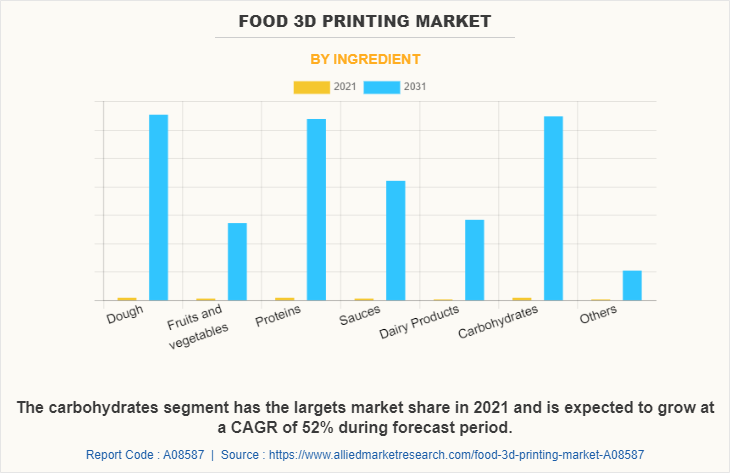
By ingredient, the carbohydrates segment accounted for a major share in the 3D Food Printing market in, and is expected to grow at a significant CAGR during the forecast period. Carbohydrates or carbs in general are sugar molecules and one of the three main nutrients along with fats and proteins, which are found in foods and drinks. Carbohydrates are one of the major sources of energy to the human’s body cells, organs, and tissues. The global carbohydrate market is growing due to the several factors such as its high usage in the production of nutritious and convenience food products coupled with high usage as ingredients in the production of various energy food products. Moreover, it is easy to customize carbohydrate containing foods according to the consumers’ need, which has a positive impact on the market.
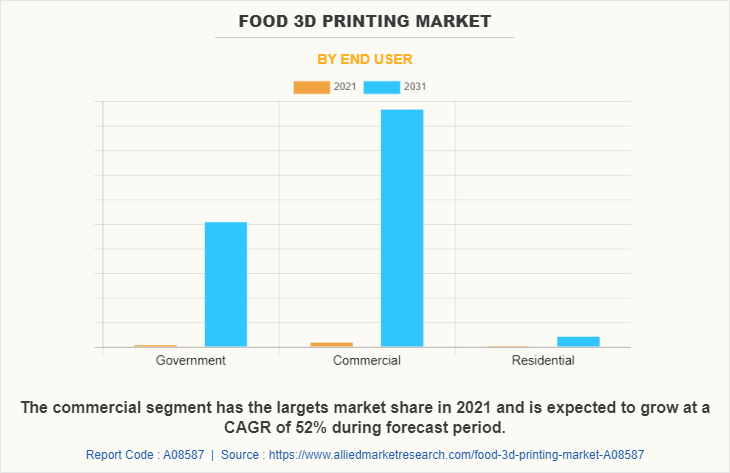
By end user, the commercial segment accounted for a major share of the market in and is expected to grow at a significant CAGR during the forecast period. Commercial segment can be classified into restaurants, bakeries, and confectionaries. The global commercial segment is growing due to the high adoption rate of 3D food printers by the confectionaries and the food 3d printing market to gain the diversity and accuracy in the manufacturing of food products within the least possible time and according to the consumers need and wants.
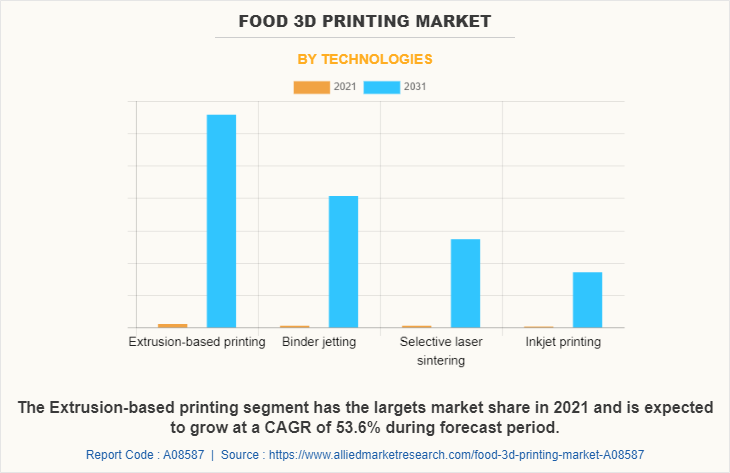
By technology, the extrusion-based printing segment accounted for a major food 3d market share, and is expected to grow at a significant CAGR during the forecast period. Extrusion-based printing fused deposition modelling (FDM) which is meant to provide the commercial manufacturers the ability to produce different shapes of food products by using different type of nutrition ingredients for the customization according to the requirements of the consumers. The global extrusion-based printing market is growing due to the several factor such as the manufacturers can make wide range of food products by using a large number of nutrients according to the requirements or the needs of the consumers. In addition, the limited cost of the digital design of an object and its ability to provide range of customizations are the key drivers of the food 3d printing industry growth. Moreover, it helps to reduce the food wastage, which is going to make positive impact on the market in the upcoming future.
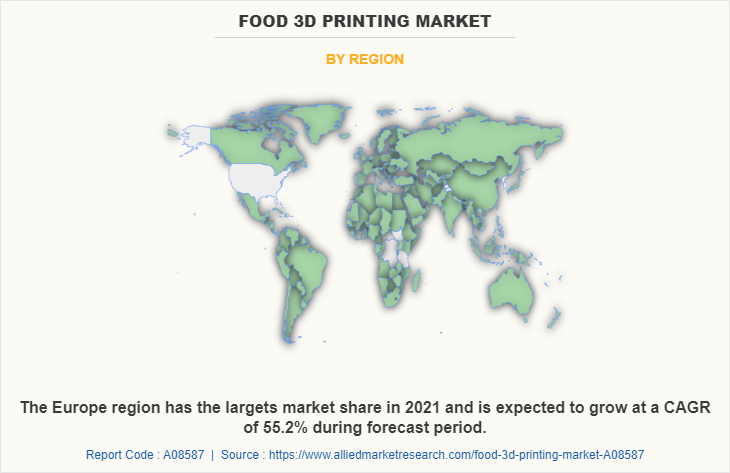
By region, Europe accounted for a major market share of the market in and is expected to grow at a significant CAGR during the food 3d printing market forecast period. In Europe 3D food printing market is increasing as it is the largest region in the term of geographical footprint and also a home to several manufacturing industry players which holds the strong technical expertise in additive manufacturing process. Also, the region is the worldwide leader in international tourism and the continuous market growth in the sector along with the adaptation of new technology by the leading manufacturers is the key driver to the market size in the region.
Competitive Analysis
The food 3d printing market key players are BeeHex, NOVAMEAT, 3Desserts Graphiques, Natural Machines, Print4taste GmbH, Barilla G. e R. Fratelli S.p.A, TNO, Aniwaa Pte. Ltd, Shiyin Technology Co., Ltd., Redefine Meat Ltd., byFlow B.V., Systems and Materials Research Corporation, Dovetailed, 3D Systems, Inc., Modern Meadow
Key Benefits For Stakeholders
- This report provides a quantitative analysis of the market segments, current trends, estimations, and dynamics of the food 3d printing market analysis from 2021 to 2031 to identify the prevailing food 3d printing market opportunities.
- The market research is offered along with information related to key drivers, restraints, and opportunities.
- Porter's five forces analysis highlights the potency of buyers and suppliers to enable stakeholders make profit-oriented business decisions and strengthen their supplier-buyer network.
- In-depth analysis of the food 3d printing market segmentation assists to determine the prevailing market opportunities.
- Major countries in each region are mapped according to their revenue contribution to the global food 3d printing industry.
- Market player positioning facilitates benchmarking and provides a clear understanding of the present position of the market players.
- The report includes the analysis of the regional as well as global food 3d printing market trends, key players, market segments, application areas, and market growth strategies.
Food 3D Printing Market Report Highlights
| Aspects | Details |
| Market Size By 2031 | USD 15.1 billion |
| Growth Rate | CAGR of 52.8% |
| Forecast period | 2021 - 2031 |
| Report Pages | 280 |
| By Ingredient |
|
| By End User |
|
| By Technologies |
|
| By Region |
|
| Key Market Players | Aniwaa Pte. Ltd, TNO, BeeHex, 3Desserts Graphiques, Modern Meadow, Redefine Meat Ltd., byFlow B.V., Shiyin Technology Co., Ltd., NOVAMEAT, Print4taste GmbH, Barilla G. e R. Fratelli S.p.A, Natural Machines, Systems and Materials Research Corporation, 3D Systems, Inc., Dovetailed |
Analyst Review
According to the insights of the CXOs, the global 3D food printing market is expected to witness robust growth during the forecast period, owing to increase in focus on expansion of food manufacturing facility, along with facility development, marketing strategies, and information exchange programs by companies to raise awareness and improve the applications for 3D food printers. Moreover, the rise in the use of 3D printers in plant-based meat alternatives has fueled the growth of the global 3D food printing market. In a study reported at ACS Food Science & Technology, the team established a new sequence of plant-based elements for 3D-printed meat alternatives. Furthermore, rise in investment in R&D activities and innovative food offerings by key players can produce new 3D food printing market opportunities.
CXOs furthermore added that an important factor driving the development of the 3D food printing market is rise in awareness among food innovators of the need to modernize food production technology. The primary reasons driving the growth of the 3D food printing market are expansion in commercial food industry, the rise in demand for personalized food products with nutrient content matched to individual organic process requirements, and growth in concerns about global food safety & development. However, the lack of original flavor is expected to hamper the growth of the 3D food printing market in the future.
The global Food 3D Printing Market Size was at $226.2 million in 2021, and is projected to reach $15.1 billion by 2031
The global Food 3D Printing market is projected to grow at a compound annual growth rate of 52.8% from 2022 to 2031 $15.1 billion by 2031
Natural Machines, BeeHex, Modern Meadow, Redefine Meat Ltd., 3Desserts Graphiques, byFlow B.V., Dovetailed, TNO, Barilla G. e R. Fratelli S.p.A, Systems and Materials Research Corporation, Shiyin Technology Co., Ltd., Print4taste GmbH, NOVAMEAT, 3D Systems, Inc., Aniwaa Pte. Ltd
By region, Europe accounted for a major Food 3D Printing Market Share of the market
Rise in demand for gourmet food, Increase in the use of 3D printers in plant-based meat alternatives
Loading Table Of Content...



